Speech Prudent Mortgage Lending Standards Help Ensure Financial Stability

Luci Ellis
Head of Financial Stability Department
Address to the Australian Mortgage Conference 2012
Sydney –
Good morning, and thank you to RFi for the opportunity to speak to you today. Property markets and financial stability are both topics that are dear to my heart, and I hope to yours as well. It has been known for generations that boom-bust cycles in asset prices can be harmful to the economy and the people in it. They are especially harmful when fuelled by easy credit. Sadly, that knowledge has not stopped the busts occurring. The source of the threat to financial stability is more often in commercial property or property development than in home mortgages, so I think we need to keep the risks posed by the housing and home mortgage markets in perspective. Still, if something did go badly wrong in the housing market, it would be painful and could damage financial stability. I therefore want to go through some of the reasons why households might default on their mortgages, explain why the US market became so distressed, and show how we can continue to avoid a similar situation.
Is housing really the problem?
Although this talk is about home mortgages, I want to emphasise that home mortgage markets with prudent lending standards do not generally pose risks to financial stability. It is not unusual for housing prices to fall, especially if they had been booming previously, or if the economy has turned down. But for that to translate into a big upswing in mortgage defaults, the economy generally has to have weakened first. That was the pattern of the housing busts of the 1930s and early 1990s in many countries. It is also what we see in Ireland, Spain and the United Kingdom today. In those countries, as in the past, commercial real estate and property development have been the bigger problems. The recent cycle in commercial property prices has been at least as large as that in housing prices for essentially every country for which we have good data, including the United States as well as countries like Spain and Ireland (Graph 1).
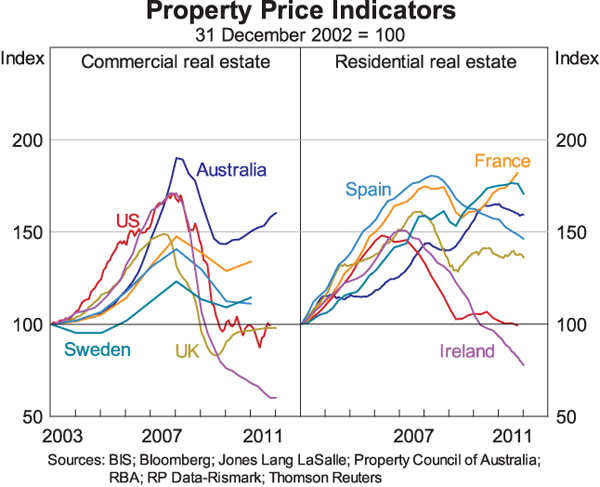
Typically, the rate of home mortgage defaults remains low enough that it does not damage the financial system as much as property-related corporate loan defaults. The effects therefore do not feed back to the real economy to the same extent. All the same, the recent US experience shows that painful housing busts can happen. We would certainly want to avoid one here. Housing lending is a larger fraction of the balance sheets of Australian banking institutions than for their US counterparts. So in the unlikely event a US-style bust did happen, it would be harmful to financial stability in Australia.
We should seek to avoid US-style housing busts, not only because they harm financial stability, but also because they impose great social costs. Losing money in a failed property investment is one thing, but how much worse would it be to lose your home? Millions of American households have lost their homes to foreclosure. Whole neighbourhoods have been blighted by empty and even uninhabitable homes. Communities are fractured and lives are disrupted, sometimes permanently.
There is no reason why Australia should follow the same path as the United States in this respect. But it is important that we continue to avoid the same mistakes. By ‘we’, I do not refer only to policymakers. Mortgage lenders need to refrain from easing lending standards the way they did in the United States. And so far, you have been refraining. It is a key difference between the two countries, and it motivates the title of my talk today.
Why do some households default on their mortgages?
There is a common misconception that US home buyers can just walk away from their mortgage, and will do so whenever the value of their home falls below their loan balance. Non-recourse lending applies in some states for some borrowers, but the law in most US states allows lenders to sue for any remaining shortfall from the proceeds of sale of foreclosed homes. It is just that many do not bother going to court to obtain a ‘deficiency judgement’, as they're known. Experience has shown that households are much less likely to default on their mortgages than a simple financial test would imply (Vandell 1995). Rather than just giving up and walking away at the first sign of difficulty, many borrowers strive to maintain their repayments or to get back on track after falling behind (Foote, Gerardi and Willen 2008).
Instead of imagining a ‘ruthless defaulter’ who walks away from their financial obligations, we need to focus more on capacity to pay and how it can decline. The reality is that things can happen to people that make it difficult to repay their loans – their relationships break down, or they lose their jobs, or a member of the family becomes too ill to work or even dies. We economists and credit risk modellers speak euphemistically of idiosyncratic shocks, but this is what we mean. Financial stability policymakers cannot legislate away these individual setbacks, but we can be alert to circumstances that could make them more common or more damaging.
The most obvious factor that can make things worse is a recession. In good times, the people most at risk of losing their jobs are less likely than average to have a mortgage. As unemployment rises, though, many more people face a loss of income, and more of them are likely to have mortgages. So the really large upswings in mortgage arrears rates have, perhaps not surprisingly, tended to occur at the same time as large increases in unemployment. This is certainly the experience in countries like the United Kingdom and Spain in recent years (Graph 2).
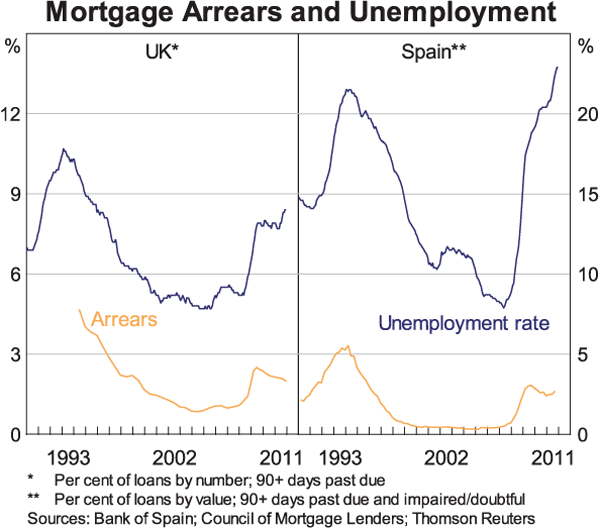
Falling housing prices are another factor that tends to result in higher rates of mortgage arrears. If something bad happens to you and you can no longer afford your repayments, it is better to sell and have a bit left over after discharging the mortgage. If the property value has fallen below the loan balance, though, you are in a much worse situation. You can't easily sell if you are in trouble or even if you just want to move to a cheaper area or a more appropriate home, or to where the jobs are.
So we need to be alert to falling housing prices, but we also need to keep them in perspective. There still needs to be an underlying problem with the borrower's ability to repay before they default. A note of caution, though: housing price growth is no longer running ahead of income growth the way it did during the 1990s and early 2000s, when the economy was still adjusting to disinflation and deregulation (Graph 3). And because inflation and thus income growth are lower than in the 1970s and 1980s, soft periods in the housing market could now be more likely to involve falling housing prices.
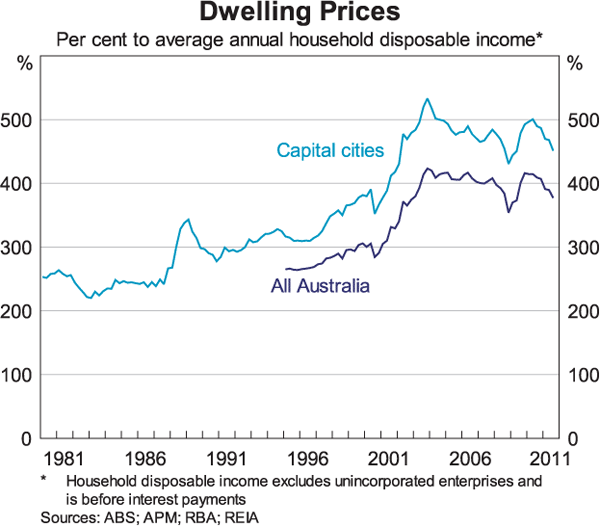
Mortgage debt is a nominal quantity, fixed in dollar terms until the borrower pays some of it down. So if periods of mild price falls are more common nowadays, households are more likely to end up in negative equity unless they do something about it, by paying back principal. I will have more to say about this in a moment. For now, just consider that higher debt burdens make it more likely that a household will run into repayment difficulty. And now that the transition period is over, low inflation makes it more likely that households in difficulty will also be in negative equity.
The meltdown in the US housing market cannot be explained by these factors alone, however. Mortgage arrears began rising rapidly well before unemployment did, even when housing prices had fallen only modestly (Graph 4). Had capacity to pay deteriorated so much? It is to this question that I now want to turn.
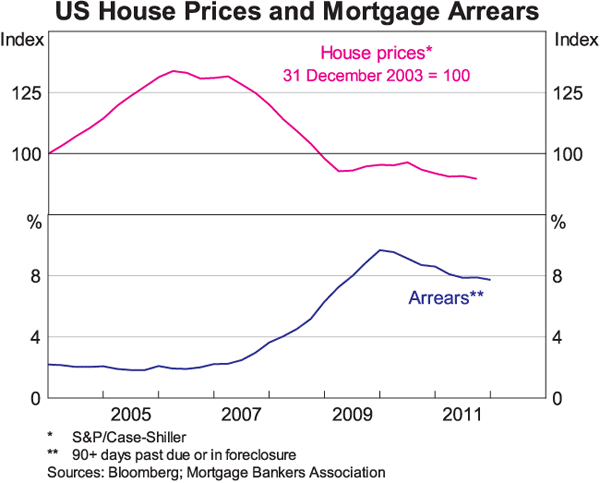
What went wrong in the United States?
Much has been written on the causes of the crisis and the housing bust that sparked it, including by me. The causes are complex, but I think they can be boiled down to three things: lax lending practices, lax lending practices, and lax lending practices. Lending standards eased in the United States far beyond what was seen in other countries over the boom period. Partly this was because certain specialist subprime lenders gained market share, but individual lenders also lowered their standards.
Subprime lending has long been a niche in US mortgage finance. The traditional players in this market understood that it was a very risky customer base. These borrowers are, after all, people with a history of missing payments on other debt. During the boom in subprime mortgages, US lenders thought they could manage their exposure to these risky borrowers by ensuring they would not remain customers for long. They tried to enforce this with loan terms that induced borrowers to refinance after a few years, like large scheduled increases in required repayments. But if credit wasn't available elsewhere and the borrower couldn't afford the higher subsequent repayments, default might have been the only option.
Much of the subprime and other non-prime lending that went on was not based on proper assessments of borrowers' ability to service the loan. Brokers and lenders did not verify incomes or other financial obligations. All they seemed to care about was the value of the collateral. If housing prices kept rising, they assumed, the borrower could either refinance or sell, and everything would be fine. Big assumption. We would never want to see this kind of asset-based lending in the Australian market.
So subprime markets and lax lending decisions were key differences between the US and Australian markets. What happens during the life of the loan also matters a great deal. Some recent research by economists at the Federal Reserve suggests that it was not high proportions of subprime loans that predicted which districts would have worse outcomes for prices and loan defaults (Barlevy and Fisher 2010). Rather, it was the proportion of new lending that was interest-only loans. These loans were not being paid down. In some cases, the loan balance was increasing through cash-out refinancing or explicit negative amortisation options.
How are Australia and other countries avoiding a US-style situation?
As the RBA has made clear many times before, one important reason Australia did not go down the same road as the United States is that lending standards didn't ease as much here. Even at its peak, subprime lending was only ever a tiny fraction of the total. Low-doc loans were also a small niche. And we never saw here the explosion of zero-deposit loans – or worse, the 125 per cent loans that were available in the United Kingdom. In Australia in recent years, around two-thirds of new mortgage borrowers from banks had an initial loan-to-valuation ratio below 80 per cent. If we look at the whole mortgage book, that fraction is even higher.
A large part of the reason why lending standards didn't ease as much here is that prudential supervision is stricter. Unlike in the United States, in Australia most mortgage lending is done by firms that are prudentially regulated. And unlike in the United States, there is only one prudential supervisor, APRA. Australian lenders can't arbitrage differences in prudential treatment across different regulators.
There are quite a few mortgage lenders that are not prudentially supervised, though, and this is where an important second line of defence comes in. Consumer protection standards around credit are a vital part of the authorities' defence against a US-style outcome, a part that in my view has been under-appreciated to date. Consumer protection standards for credit products have in recent years been broadened, and shifted to a national framework administered by ASIC. But the earlier state-based system still had the three features most needed to avoid US-style problems: it was nationally consistent; it covered all consumer borrowers; and it covered all lenders consistently, regardless of whether they were prudentially supervised or not.
Another important mainstay against a US-style outcome is that many Australian households actually pay their mortgages down, often quite quickly (Graph 5). Estimates vary, but it seems as many as half of owner-occupiers with mortgages pay it down faster than the contract requires. The faster they pay it down, the less likely they are to end up in negative equity; they have a head start if prices should fall. Some of them must be running their debt down quite fast: data from lenders suggest that the total amount of excess repayments made is similar to the amount of required repayments. This is a welcome feature of the Australian market that is rarely seen overseas.
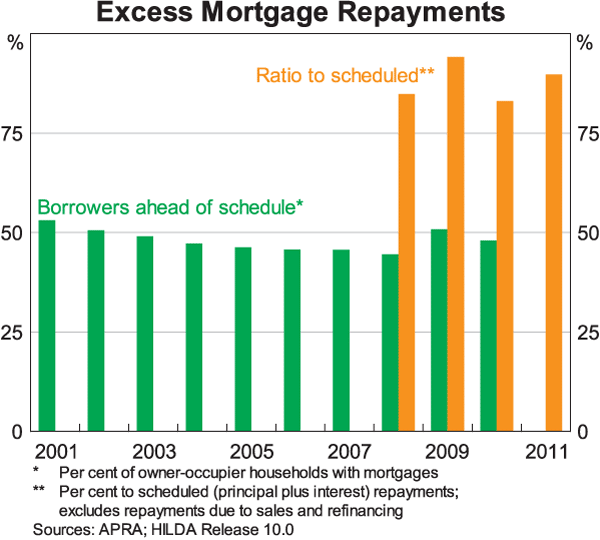
The international regulatory community is all too aware of the role of lax lending practices in the US meltdown. In response, the Financial Stability Board (FSB) has drafted some global principles for sound mortgage lending practices, which all countries should follow.[1] These principles were released for consultation last year and should be finalised quite soon. I was part of the group that drafted these principles, so naturally I commend them to you. The Principles recognise that lending standards are multidimensional. This is a crucial point. Many factors affect a borrower's capacity to repay their loan. Some of them are complementary; others can offset each other.
The international debate about so-called ‘macroprudential policy’ and financial stability policy more generally has been quite focused on housing and mortgages. For instance, there has been a lot of talk about the idea of the authorities setting a cap on loan-to-valuation ratios (LVRs), and periodically adjusting that cap. Some countries already do this. The FSB did not mandate or specifically encourage such a policy tool, and we do not think it is necessarily warranted in the Australian environment. It is, of course, important that borrowers put some of their own resources into the purchase of their home. But the focus should not be on maximum LVRs at origination, ignoring all other aspects of lending standards. In my view, capacity to service the loan is far more important.
Looking at LVRs just at origination also ignores how these ratios evolve over the life of the loan, and how they are distributed across households. In Australia, households in aggregate used to have very little debt against their homes, relative to the value of those homes, back when the financial sector was highly regulated and inflation eroded that debt quickly (Graph 6). Obviously this measure of leverage has risen since then. It would not be desirable for this ratio to approach that in the United States. However, we do not think the most effective way to prevent that would be to impose a cap just for new borrowers.
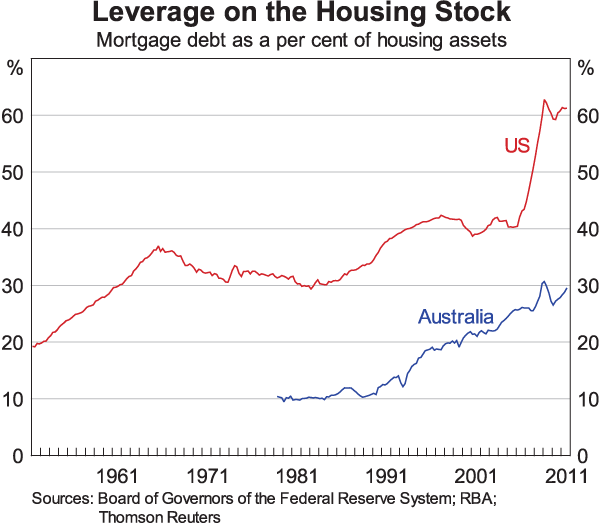
Nor do we think it is sensible to rely on simple rules like a ratio of loan amount to income; nowadays many Australian lenders sensibly take borrowers' other obligations and expenses into account when determining how much debt can be serviced, and thus how much they will lend.
The Principles themselves deal with the various dimensions of lending standards in their own order, but I like to group those dimensions into five categories.
- First, serviceability: or in simpler terms, capacity to pay. This is covered in Principle 2 of the FSB proposal. It is the crucial decision of how much to lend. And I think it is the decision point where it is all too easy to become complacent and lend too much.
- Lenders should also consider over what term the loan is to be serviced. The term affects how quickly the loan is paid down. As the Principles also note, if the loan term extends past normal retirement ages, lenders need to allow for that when assessing capacity to pay. Don't assume, without good reason, that borrowers will necessarily downsize when they retire.
- Amortisation of the loan is also important. Principle 2.1 in the FSB document states: ‘Jurisdictions should ensure that lenders appropriately assess borrowers' ability to service and fully repay their loans without causing them undue hardship.’ The National Consumer Credit Code in Australia says something similar. Interest-only loans have their place, but the point about mortgage lending is that the household should be able to pay it off eventually. Otherwise we would be in the undesirable world of asset-based lending.
- Of course, we do have to think about collateralisation, or loan-to-valuation ratio. This is covered in Principle 3 of the proposal, where the FSB emphasised the need to avoid allowing higher LVRs just because housing prices happen to be rising. Principle 4 covers how that valuation should be arrived at.
- Finally, subordination greatly affects loan performance. Some of the worst loss outcomes in the US meltdown occurred in portfolios of second mortgages, and the structured securities based on them. Sometimes the lender for the first mortgage didn't even know that the second mortgage existed.
Within each of these dimensions, both lenders and policymakers need to think about more than just the explicit loan terms. We must consider the variability of those terms, and of the circumstances of the borrower. For example, does the borrower have an unusually volatile income or employment history? And have both the borrower and lender allowed enough of a margin to cope with interest rate changes? We must also consider who has the option to vary those loan terms. Australian borrowers' tendency to repay ahead of schedule is a good example of this. And we must consider whether and how the lender can verify that the information they base their decisions on is true. This last aspect is so important that the FSB made it the first of the Principles. The problems with stated income loans – and even outright fraud – in the US market during its boom, show how important verification can be.
Conclusion
In conclusion, I would like to stress that Australia, like many other countries, does not have the ingredients needed to create an outcome like that in the United States. But in ensuring that remains the case, much will depend on you, the mortgage lenders.
If I may use an analogy: we know that the key to maintaining a healthy weight is to have a healthy diet and to exercise regularly. Yet we find it hard to avoid temptation. And so it is with maintaining a healthy mortgage market. It is always tempting to ease lending standards, and dress that up as responding to competition or giving the customer a better deal. It must be hard to resist the disappointed customers who just want to borrow that bit extra to purchase their dream home, especially when the loan officer is also trying to make budget on new loan approvals. But in the experience of the United States, we have seen what can happen when lenders yield to that temptation.
If lenders were to ease lending standards beyond the point of prudence, they would not be doing anyone any favours. Their customers, the borrowers, would be overburdened by their debts. The firm themselves would face difficulties if loan defaults were to rise. And financial stability would be much harder to maintain. I am pleased to say that I do not currently see signs of widespread lax lending practices here in Australia. Indeed, APRA has been consulting with the boards of the larger banking institutions about their housing lending standards. But there will be times – good times, when everything seems rosy – when lenders will find it hard to maintain the necessary prudence. While the regulators can take actions and central bankers like me can warn of the risks, in the end we all have a stake in maintaining financial stability. For financial stability is in the collective interest of all Australians.
Thank you for your time.
Endnote
See <http://www.financialstabilityboard.org/publications/r_111026b.pdf>. The report uses the term ‘underwriting practices’, which is commonly seen in the United States and some other jurisdictions. [1]
References
Barlevy G and JDM Fisher (2010),‘Mortgage Choices and Housing Speculation’, Federal Reserve Bank of Chicago Working Paper WP-2010-12.
Foote CL, K Gerardi and PS Willen (2008), ‘Negative Equity and Foreclosure: Theory and Evidence’, Journal of Urban Economics, 64(2), pp 234–245; also available as Federal Reserve Bank of Boston Public Policy Discussion Paper No 08-3.
Vandell KD (1995), ‘How Ruthless is Mortgage Default? A Review and Synthesis of the Evidence’, Journal of Housing Research, 6(2), pp 245–264.